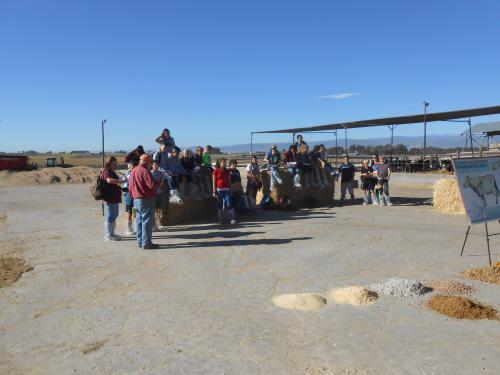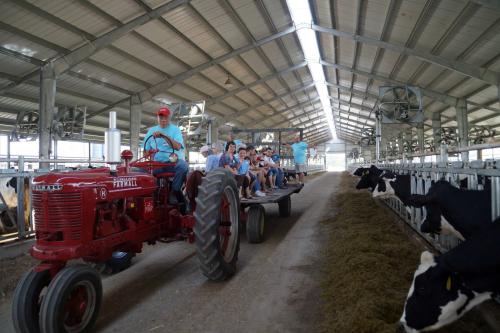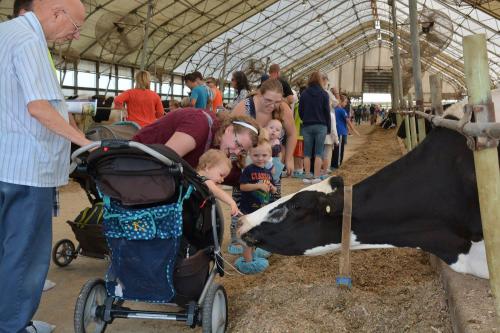Dairy farm tours and open houses are always a good idea
In a society where the majority of the population is disconnected from agriculture, opening the doors of your farm to the public can have a big impact on their lives, and ultimately on the dairy industry.

Annual ice cream social at Preston Farms from Branch County, MI. | Photo by Michigan State University Extension
I didn’t grow up on a farm, but as a kid, I always knew that the glass of milk I had for breakfast came from cows that lived on a dairy farm. Nowadays, I have heard too many kids saying that milk comes from the grocery store, ignoring the role of cows and agriculture involved in milk production. During vet school, I learned how dairy farmers take care of their animals and make their livestock their number one priority. I also learned how all farmers care for the environment and take efforts to produce milk that is highly nutritious and safe. An average American is not aware of that, and if we add the occasional bad press and fake information from the internet (e.g. animal abuse, antibiotics in milk), he or she might even think the contrary.
In recent years, farm tours and open houses have become more popular among dairy farms. At the 2017 World Dairy Expo, multiple dairy farms offered virtual tours where they shared the history of the dairy, showed the facilities and highlighted different features of the farm. The majority of those dairies see the value of tours or open houses and they offer them in different ways. Farm tours and open houses are an excellent and effective way to show what your dairy farm is doing to care for the animals, the land and the environment, and educate the attendees regarding different aspects of dairy farming.
Planning an event like this may take a long time, especially if you are doing it for the first time. If you are thinking about hosting a tour or open house at your farm during the summer or early fall, you should begin planning four to six months in advance. Hosting an open house will require you to decide what aspect of your dairy farm you would like to emphasize, what business and institutions could you partner with and identifying safe walking paths for the public. Along with decision making, you will also have to consider how a limit of attendees, where the public can park, accessibility for the elderly and people with disabilities, insurance for coverage in case of accidents, permits from the health department and recruiting volunteers.
If you’re looking for ideas for bringing consumers and public to your farm, Michigan State University Extension can help you. Here are a few examples of the different options to host an event:
Tours
Tours can be the simplest option. The cost can be low to none. Normally they include a guided walk to different areas of the facility while either the guide is explaining and answering questions or leading the public to a station where one or more people explain what goes on in that area of the dairy. Usually, food is not provided. You can offer the tours upon request, on a regular basis or once a year.

La Luna Dairy, a farm in Larimer County, CO, located right on the city limits, invites their local school’s eighth grade science class to their farm every year. They partner with Colorado State University professors, Extension specialists and local consultants, who set up educational stations across the dairy including: ruminants and feed, milking parlor, calving and newborns, manure management and dairy products. They make sure to mention the connections between the different stations, such as how mastitis management is connected to milk quality. The students walk from their school to the dairy along with teachers and chaperons. Once at the farm, they put on disposable booties and the class is divided in smaller groups that will go to each station.
a
Annual visit from 8th grade class to La Luna Dairy,
Larimer County, CO. 2017. | Photo by La Luna Dairy
Hudson Dairy located in Lenawee County, MI offers tours upon request. The tour starts with a video of the farm, and then personnel from the farm guide the guests through the dairy while explaining the different stops, for example the care that the cows and calves need and how the cows are milked.
At Shuler Dairy, a centennial dairy farm in Berrien County, MI, they show their guests how robots and cow comfort impacts the life of dairy cows. Public can access the educational tour, that also includes a video for a small fee, and after the tour they can shop local products and enjoy fresh ice cream.ough the dairy while explaining the different stops, for example the care that the cows and calves need and how the cows are milked.
Ice Cream Social

The name says it all. People tour the farm facility where they learn about
dairy and enjoy ice cream. Normally this would only be offered once a year since it involves a lot of work in the planning and execution and can be costly. You would probably need volunteers to help with the ice cream scooping and other tasks. Because food is provided, a permit from the local health department might be needed.
Preston Farms from Branch County started an ice cream social tradition almost nine years ago. The Preston family opens the doors of their farm for four hours and they make sure nobody leaves without having learned something about dairy farms nor without having ice cream. For last year’s
Annual ice cream social at Preston Farms from Branch County,
MI. 2014. | Photo by Michigan State University Extension
For last year's event, they had almost 200 volunteers including friends and family, neighbors, local farmers and consultants, and around 1,300 attendees. They have multiple educational stations where public can even experience things like how the vacuum from a milking machine feels. They also have different entertainment for kids, including the popular corn box and hay rides that goes through the barns, by the manure pit and by the silage where a volunteer explains the details and answers questions.

Breakfast on the Farm
Teach others about agriculture while starting the day in the best way by hosting a Breakfast on the Farm.
Depending on how complex the breakfast you offer is and how many people you expect, it can be very time consuming in the planning and execution and also expensive. Often, this is a once in a lifetime event because of its magnitude - upwards of 2,000 guests. You will need many volunteers and at least six months of planning.
Breakfast on the Farm at Hood Farms Family Dairy from Van Buren
County, MI. 2015. | Photo by Michigan State University Extension
Michigan State University Extension offers a program to help farmers with the planning and execution of their breakfast on the farm. Farmers all over the state of Michigan can apply to the program, which has helped at least one dairy every summer in the past eight years to host a Breakfast on the Farm.
These are just a few ideas, but there are endless opportunities to educate the public and consumers about what dairy farmers are doing every day to feed the nation.



 Print
Print Email
Email




